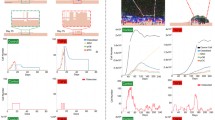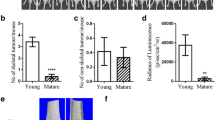Abstract
Prostate cancer (PCa) impacts over 180,000 men every year in the USA alone, with 26,000 patients expected to succumb to the disease (cancer.gov). The primary cause of death is metastasis, with secondary lesions most commonly occurring in the skeleton. Prostate cancer to bone metastasis is an important, yet poorly understood, process that is difficult to explore with experimental techniques alone. To this end we have utilized a hybrid (discrete–continuum) cellular automaton model of normal bone matrix homeostasis that allowed us to investigate how metastatic PCa can disrupt the bone microenvironment. Our previously published results showed that PCa cells can recruit mesenchymal stem cells (MSCs) that give rise to bone-building osteoblasts. MSCs are also thought to be complicit in the establishment of successful bone metastases (Lu, in Mol Cancer Res 4(4):221–233, 2006). Here we have explored the aspects of early metastatic colonization and shown that the size of PCa clusters needs to be within a specific range to become successfully established: sufficiently large to maximize success, but not too large to risk failure through competition among cancer and stromal cells for scarce resources. Furthermore, we show that MSC recruitment can promote the establishment of a metastasis and compensate for relatively low numbers of PCa cells seeding the bone microenvironment. Combined, our results highlight the utility of biologically driven computational models that capture the complex and dynamic dialogue between cells during the initiation of active metastases.
Similar content being viewed by others
References
Aceto N, Bardia A, Miyamoto DT, Donaldson MC, Wittner Ben S, Spencer JA et al (2014) Circulating tumor cell clusters are oligoclonal precursors of breast cancer metastasis. Cell 158(5):1110–1122
Anderson A (2005) A hybrid mathematical model of solid tumour invasion: the importance of cell adhesion. Math Med Biol 22(2):163
Araujo A, Baum B, Bentley P (2013) The role of chromosome missegregation in cancer development: a theoretical approach using agent-based modelling. PLoS ONE 8(8):e72206
Araujo A, Cook LM, Lynch CC, Basanta D (2014) An integrated computational model of the bone microenvironment in bone-metastatic prostate cancer. Can Res 74(9):2391–2401
Bussard KM, Gay CV, Mastro AM (2007) The bone microenvironment in metastasis; what is special about bone? Cancer Metastasis Rev 27(1):41–55
Celià-Terrassa T, Kang Y (2016) Distinctive properties of metastasis-initiating cells. Genes Dev 30(8):892–908
Chéry L, Lam HM, Coleman I, Lakely B (2014) Characterization of single disseminated prostate cancer cells reveals tumor cell heterogeneity and identifies dormancy associated pathways. Oncotarget 5(20):9939
Cook LM, Shay G, Araujo A, Aruajo A, Lynch CC (2014) Integrating new discoveries into the “vicious cycle” paradigm of prostate to bone metastases. Cancer Metastasis Rev 33(2–3):511–525
Cook LM, Araujo A, Pow-Sang JM, Budzevich MM, Basanta d, Lynch CC (2016) Predictive computational modeling to define effective treatment strategies for bone metastatic prostate cancer. Sci Rep 6:1–12
Gundem G, Van Loo P, Kremeyer B, Alexandrov LB, Tubio JMC, Papaemmanuil E et al (2015) The evolutionary history of lethal metastatic prostate cancer. Nature 520(7547):353–357
Keller ET, Brown J (2004) Prostate cancer bone metastases promote both osteolytic and osteoblastic activity. J Cell Biochem 91(4):718–729
Lu H (2006) Inflammation, a key event in cancer development. Mol Cancer Res 4(4):221–233
Pfeilschifter J, Wolf O, Naumann A, Minne HW, Mundy GR, Ziegler R (1990) Chemotactic response of osteoblastlike cells to transforming growth factorβ. J Bone Miner Res 5(8):825–830
Quaranta V, Weaver AM, Cummings PT, Anderson ARA (2005) Mathematical modeling of cancer: the future of prognosis and treatment. Clin Chim Acta 357(2):173–179
Turajlic S, Swanton C (2016) Metastasis as an evolutionary process. Science 352(6282):169–175
Yotsumoto F, Tokunaga E, Oki E, Maehara Y, Yamada H, Nakajima K et al (2013) Molecular hierarchy of heparin-binding EGF-like growth factor-regulated angiogenesis in triple-negative breast cancer. Mol Cancer Res 11(5):506–517
Acknowledgements
We would like to acknowledge Dr. Anderson from Moffitt’s Integrated Mathematical Oncology Department for helpful discussions. AA, LC, CCL and DB were partly funded by an NCI U01 (NCI) U01CA202958-01 and a Moffitt Team Science Award. AA was partly funded by a Department of Defense Prostate Cancer Research Program (W81XWH-15-1-0184) fellowship. LC was partly funded by a postdoctoral fellowship (PF-13-175-01-CSM) from the American Cancer Society.
Author information
Authors and Affiliations
Corresponding authors
Ethics declarations
Conflict of interest
None.
Rights and permissions
About this article
Cite this article
Araujo, A., Cook, L.M., Lynch, C.C. et al. Size Matters: Metastatic Cluster Size and Stromal Recruitment in the Establishment of Successful Prostate Cancer to Bone Metastases. Bull Math Biol 80, 1046–1058 (2018). https://doi.org/10.1007/s11538-018-0416-4
Received:
Accepted:
Published:
Issue Date:
DOI: https://doi.org/10.1007/s11538-018-0416-4









